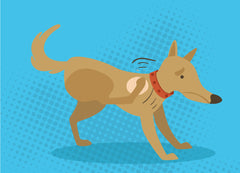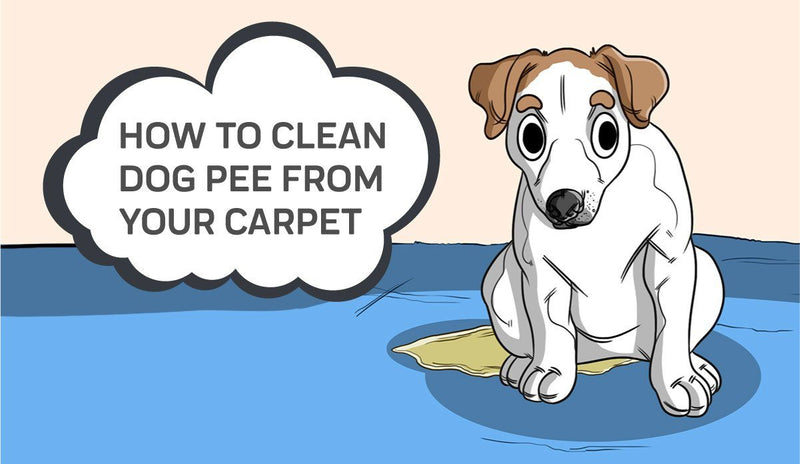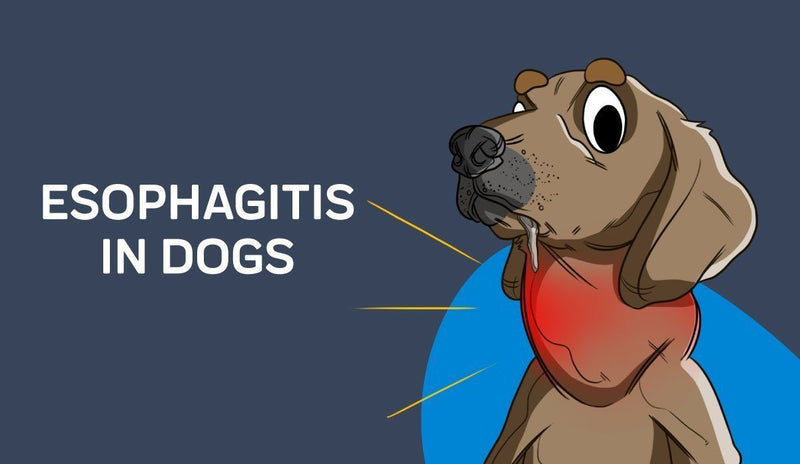
Worrying about your pet is something that most every pet parent has had to deal with. From minor issues to serious ones that affect them long-term, worries and concerns about your pet are normal. Unfortunately, dogs can get health issues just like their human parents. Some are similar to what humans get, and others are unique to animals. It is important for pet parents to know what to look out for when it comes to their dog's health. One health problem that dogs face is a skin disease known as mange.
TABLE OF CONTENTS
1. What is Mange?
2. Demodectic Mange
3. Sarcopetic Mange
4. Signs and Symptoms of Mange in Dogs
5. How is a Diagnosis of Mange in Dogs Achieved?
6. Treatments For Mange in Dogs
7. Treatments for Demodectic Mange
8. Treatments For Sarcoptic Mange
9. The Other Two Types of Mange in Dogs
10. Alternative Treatments For Mange in Dogs
The skin disease comes from mites that infest the dog's skin. Mange in dogs is in two forms. The first form of mange in dogs is demodectic mange and the second form is sarcoptic mange. The two forms are different, and it is imperative that pet parents understand the differences so that they can prevent it or treat it.
Below we will discuss the types of mange in dogs, the differences in the two types, and what you can do to treat it or prevent it.
What is Mange?
Most pet parents have heard of mange but aren't exactly sure where it comes from and what it can do to a dog. Mange is a skin disease that is parasitic and comes from a large infestation of mites on the dog's skin and hair.
There are usually a small number of parasites on a dog's body, but mite infestations are far more visible and noticeable as it becomes large in number. Mites are easily transferred when dogs are around each other closely, like mothers and pups and dogs that live in the same home. While a small number of mites can be completely normal, a large infestation is not, and it can cause mange quickly. A new strain of mites invading the dog's skin or hair can also cause mange.
Types of Mange in Dogs And Causes
The two main types of mange in dogs are demodectic mange and sarcoptic mange, and we will go over both of those in the article below.
Demodectic Mange
The type of mange known as demodectic mange occurs in dogs when their immune system is compromised and cannot properly regulate the mites or heal well. This means that like a human being with a compromised immune system, a dog's immune system cannot fight off a mite infestation the way they should be able to.
The compromised immune system will make it too hard for the dog to fight off the infestation of mites and result in the skin disease of mange. Most dogs naturally develop an immunity to regular mites on the body, but it cannot control the mite infestation or fight off the development of skin disease properly due to the immune system being in a state of weakness.
Two situations often occur that result in demodectic mange. For aging dogs, it comes from the issues and health concerns that can happen as they grow older. Health issues that are underlying can make it hard for their immune systems to work properly and makes it harder for them to fight off infections. For example, an older dog with cancer or hormone imbalances may suffer from a weak immune system that is compromised and unable to fight off things like demodectic mange.
The second situation that often occurs in a weakened immune system is a young puppy. Puppies under the age of two years have a weaker immune system merely because they are so young. Their immune system grows stronger as they grow older, much like their human parents. The good news is that demodectic mange is not contagious to humans or to other dogs that may reside in the household or be around them. Pet parents will only have to worry about the pet that is infected and getting them better and won't have to be concerned about it spreading to other dogs or people in the home.
Sarcoptic Mange
The second form of mange in dogs is sarcoptic mange. Sarcoptic mange derives from what is called canine scabies. Canine scabies is also referred to as burrowing mites and maybe what most people have heard of. Sarcoptic mange in dogs comes from burrowing mites that infest the skin. Most dogs get sarcoptic mange from being around other dogs that have this infestation.
These burrowing mites will burrow into the skin, and the female mites will lay eggs. These eggs hatch between three and seven days later and are how they multiply so quickly. It will usually be noticeable if they have this as they will often scratch uncontrollably in certain spots. Unfortunately, sarcoptic mange is very contagious and can affect both humans and other dogs. This means that treating right away will be essential to prevent others from getting it. Most of the time, this type of mange in dogs will come directly from another pet that has sarcoptic mange. It is advised to try and find out where it originated from so that the other dog can be treated right away as well.
Unfortunately, many kennels and animal shelters experience a high rate of mange. This is because dogs are often kept close to each other in tight quarters. It is a significant issue and one that must be spotted right away. The sooner it is detected and treated, the better. Stopping the spread is vital as it is highly contagious and is why many workers in places where there are a lot of animals are trained to look out for signs of mange in dogs. Pet parents that have multiple dogs should also keep a close eye on their pets and make sure to look over their skin and hair regularly.
Signs and Symptoms of Mange in Dogs
The signs and symptoms of mange are different in each type of common mange in dogs. We will go over the common signs and symptoms of mange in dogs below:
Demodectic Mange Symptoms:
- Alopecia
- Hair Loss
- Lesions
- Scabbing
- Red Skin
- Sores
- Rashes
- Skin Discomfort
- Constant itching
Demodectic mange can manifest in two ways: localized and generalized. Localized demodectic mange means that it is localized to a specific area. Generalized demodectic mange will be located in areas all around the body.
Localized demodectic mange will be seen in one spot and will be characterized by a small area having redness, hair loss, or noticeable bald spots. The area of localized demodectic mange will sometimes have raised spots that look a lot like pimples. Some dogs are very uncomfortable with this and will scratch the area constantly or whimper more than average. Other dogs don't even show symptoms of having an issue.
The generalized version of demodectic mange will show up all over the body and is often much more noticeable. The dog will have hair loss and redness all over the body, and they can sometimes develop symptoms of fever, swollen footpads, or a bacterial infection. It will likely be easy to notice for the pet owner, and the dog will likely be experiencing a lot of discomfort and pain. Dogs with generalized demodectic mange will usually scratch continuously, whimper, and be less active overall. Their appearance will be dramatically changed in a relatively short period of time due to the hair loss and skin irritations that occur.
Sarcoptic Mange Symptoms:
- Scabbing
- Skin redness
- Excessive Itching
- Alopecia
- Sores
- Rashes of the skin
Symptoms of sarcoptic mange typically show up within about of week from initial exposure. The sores will begin to show up, and the dog will likely feel discomfort from the mites that are burrowing into the skin.
They will likely scratch uncontrollably, and this is definitely not good as it can expose them to infections from the open areas of skin that have been scratched off. Sarcoptic mange may start small and look like it is staying in one spot, but it will often quickly spread to other parts of the body.
The first symptom of sarcoptic mange is seemingly uncontrollable itching and scratching at small spots on the skin. These sores will start to develop scabs and dogs will often try to continue itching the area. This is a significant concern as the scabs being torn off can expose dogs with sarcoptic mange to bacterial infections getting into the bloodstream. It will be vital to begin treating the dog right away so as to prevent this from occurring and to protect them from getting any sicker.
How is a Diagnosis of Mange in Dogs Achieved?
Getting mange in dogs diagnosed is almost always done through an appointment and comprehensive exam with your trusted veterinarian. Dogs that are suspected of having mange by a vet will often be subject to a thorough exam that includes collecting scrapes of skin. These skin scrapings will then be looked at through a microscope to see if there is a mange present.
Most vets will get the skin scrapings by using a specialized scalpel that they have. It will scratch the surface of the skin and efficiently collect the scrapings for inspection. They will be looking for signs of mites in these skin scrapings. Your pet may have a small spot where the skin was scraped during the examination; however, the spot usually heals quickly and won't be noticeable after several days.
The skin scrapings will typically be collected from all over the dog's body so that they can see whether it is localized or generalized. The vet will then inspect the scrapings under a microscope to look for evidence of mites. They may also collect blood or stool samples from your pet. The veterinarian can let you know as soon as the results are back whether or not your dog has mange and will advise on treatment options.
Treatments For Mange in Dogs
The treatments for mange in dogs will depend on the type of mange that they have, the severity of the case, and the general overall health of the pet. The standard treatments for both demodectic mange and sarcoptic mange will be discussed in detail below.
Treatments for Demodectic Mange
Treatments for demodectic mange are often applied topically. Two topical medications often given are Benzoyl peroxide and Goodwinol ointment. Unfortunately, these are usually not enough to treat the severity of symptoms of demodectic mange in dogs.
For some cases of demodectic mange, Amitraz is prescribed by the veterinarian. Amitraz is an insecticide that is prescribed for killing Demodex mites. This insecticide does kill Demodex mites and other skin mites that are affecting pets and is often prescribed for severe cases. However, some pet parents are not sure about giving their dog this prescription medication. There have been some cases of pet toxicity in the use of Amitraz. Also, it has a list of side effects that are very concerning and can make a pet parent begin to wonder whether it really is a good option for their dog. It is imperative to discuss with a trusted veterinarian whether using Amitraz is the right choice for your pet and to do as much research as possible about potential side effects and toxicity issues.
Some other medications that could be prescribed by a vet are ivermectin and milbemycin oxime. This is often prescribed for localized mange. As always, we advise that you talk to your vet about any treatments and get their advice.
Treatments For Sarcoptic Mange
The treatments for sarcoptic mange in dogs is very different as it is the most contagious form of mange and must be treated promptly. Finding out the source of the sarcoptic mange will be the first step in treating this due to its contagiousness. This means inspecting all pets that have come in contact with yours to see if they have these pesky burrowing mites in the skin. Looking for obvious signs like scabs and redness is advised.
Trimming the dog's fur is a good idea for treating sarcoptic mange as it allows visibility of sores, mites, and other issues and allows them to be bathed with a special medicated shampoo that can help them. Medicated shampoo given as a treatment for sarcoptic mange in dogs is anti-parasitic and anti-seborrheic.
The medicated shampoo will be applied to the dog on a bi-weekly basis for several weeks or more, and this is to ensure that the skin is healing. This is often done in combination with a lime dip or with the medication Amitraz so as to kill the burrowing mites that have infected the pet's skin. When done in conjunction, they can kill the burrowing mites and treat the infected areas of skin that are causing discomfort and pain to the dog and allow the healing process to occur.
If your dog develops any infections, it will be important to give them any prescribed antibiotics. This is to get rid of the infection as soon as possible. Also, washing any and all dog bedding and areas of carpet that they have come in contact with will be important. This is to kill any mites that have detached from the skin. The good news is that mites don't survive long when not on the skin. It is important to stay in contact with the veterinarian during the process so that they can be updated about any concerns that you may have and give advice and guidance to you.
The Other Two Types of Mange in Dogs
There are two other types of mange in dogs that are not as common as demodectic and sarcoptic mange. The two less common forms of mange are known as Cheyletiellosis and ear mites. Cheyletiellosis is a type of mange that is visible to the human eye and owners can often see these tiny mites going across their dog's skin. It has been called "walking dandruff" due to its appearance and similarity to dandruff in the hair of humans.
Unfortunately, cheyletiellosis is very contagious to both humans and dogs. Most of these cases are treated with lime or Amitraz dips. This is often done along with the oral or injectable form of ivermectin. It is also advised to wash any and all bedding that the dog has come in contact with and clean any areas that they regularly tread or lie on. This is to prevent it from spreading to other animals or people in the home.
The other type of mange that is less common is ear mites. Most pet owners have heard of ear mites in passing. Ear mites like to hang out on the exterior portion of the ear, and they can become an infestation quickly when there are enough of them on the ear. These pesky mites are highly contagious between animals and should be treated right away. The ear will often become red and inflamed, and the dog will often scratch the affected ear much more than usual. Ear mite treatment starts with removing the discharge in the ear. This discharge is usually eliminated with a topical medication of some sort, or it is done in the veterinary office. Often, veterinarians will prescribe Tresaderm to place in the dog's ear, and it is vital for pet parents to follow the directions given precisely.
Alternative Treatments For Mange in Dogs
Indeed, it is important to follow the instructions given by your dog's trusted veterinarian. This is to ensure that they have the best care possible. However, there is often a dog that is very distressed and in pain to deal with during the treatment of mange. Seeing your furry friend in pain is not easy to deal with. Calming their nerves and helping with their pain and discomfort is a priority for many pet parents that have a dog dealing with mange.

Natural alternative treatments for mange in dogs can help your furry friend feel better while they are fighting this skin disease. For example, CBD has become a popular natural alternative for pet parents that don't want to always rely on medications that have concerning side effects. CBD Oil For Dogs can be given to your dog as a natural alternative. It is organic and all-natural and a great choice for pet parents that are concerned about prescriptions or chemicals with side effects.

CBD oil has been shown to help with inflammation, anxiety, and pain. All of these benefits in an organic substance is quite amazing, indeed. For pet owners that know their dogs' love treats, a good option to give them the benefits of CBD is to give them CBD Hemp Treats For Dogs. These hemp treats are organic and derived from the hemp plant. They are entirely safe and have no intoxicating properties that some worry about. In short, that means that your dog will not be getting high and will simply be enjoying natural health benefits.
CBD is being investigated all over the world for many uses. However at this time, as the manufacturer of CBD products, we are not allowed to discuss that subject publicly nor we are not allowed to imply that CBD can be used for any specific treatment.
Sources:
Sarcoptic Mange in DogsSarcoptic vs. Demodectic Mange in Dogs
Hemp Dog Treats
CBD Oil for Dogs
Ear Mites In Dogs
















